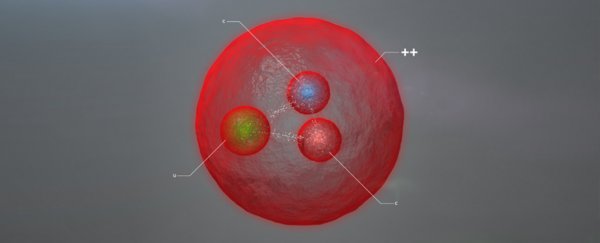The Large Hadron Collider has once again done what it does best – smash bits of matter together and find new particles in the carnage.
This time physicists have come across a real charmer. It's four times heavier than a proton and could help challenge some ideas about how this kind of matter sticks together.
We've seen a lot of interesting new particles from CERN's Large Hadron Collider "beauty" (LHCb) collaboration, which is a little sister to the ATLAS and CMS experiments that brought us the famous Higgs boson a few years back.
The experiments run in CERN's colliders all involve accelerating matter and then bringing it to a quick stop. The resulting burst of energy results in a shower of particles with different properties, most of which we're pretty familiar with.
Running these experiments over and over again and doing the maths on the sizes and behaviours of the particles as they form and interact with one another can occasionally provide something different.
We can now officially add a new kind of baryon to the zoo of particles, one that was already predicted to exist but never before seen.
The two baryons you're no doubt most familiar with are the ones that make up an atom's nucleus, called protons and neutrons.
Baryons are effectively triplets of smaller particles called quarks, which are elementary particles meaning they aren't made up of anything smaller themselves.
Quarks come in a variety of flavours, oddly called up, down, top, bottom, charm, and strange. It's combinations of these that give us different bosons. Current models predict there are a bunch of ways quarks can make baryons, with some more common than others.
Protons consist of two ups and a down quark, while neutrons are two downs and an up. These quarks stick together under what's called the strong nuclear force, which is caused by the swapping of particles called gluons. Never let it be said that physicists lack a sense of humour.
This new baryon – made when two charm quarks and a single up bound together – was given the less whimsical name Xi cc++, so they can't all be winners.
Quarks have different masses, and charm is a beefy one. That makes this baryon a touch on the heavy side, which is good news for particle physicists.
"Finding a doubly heavy-quark baryon is of great interest as it will provide a unique tool to further probe quantum chromodynamics, the theory that describes the strong interaction, one of the four fundamental forces," said Giovanni Passaleva, the spokesperson for the LHCb collaboration.
Seeing how this particle keeps itself together compared to the predictions made by current models will help give the going theories a good shake.
Being made of two heavy quarks should give Xi cc++ a slightly different structure to protons and neutrons.
"In contrast to other baryons, in which the three quarks perform an elaborate dance around each other, a doubly heavy baryon is expected to act like a planetary system, where the two heavy quarks play the role of heavy stars orbiting one around the other, with the lighter quark orbiting around this binary system," says former collaboration spokesperson Guy Wilkinson.
If you're wondering where this baryon has been hiding all this time, like many particles it doesn't hang around very long. It wasn't seen directly, but was recognised by the particles it broke into.
The LHCb experiment is a champion at spotting these kinds of decay products, as well as making heavy quarks.
The discovery has a high statistical significance at 7 sigma. Physicists break out the champagne at 5 sigma, so we can be pretty confident Xi cc++ was produced.
If you're playing Standard Model bingo, that's one more to cross off your list.
This research has been submitted to Physical Review Letters.
